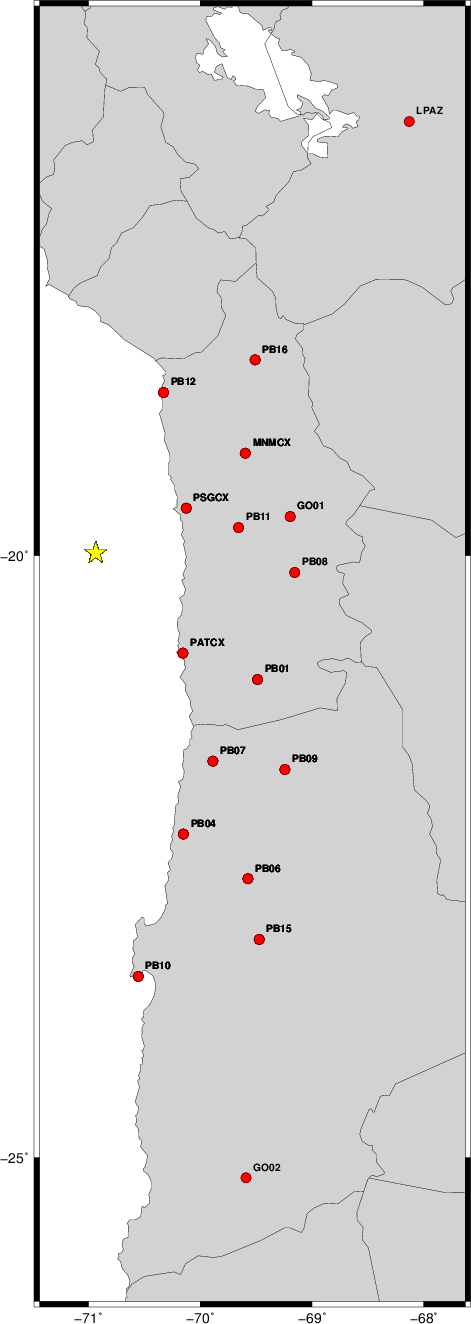
2014/04/11 08:55:55 -19.976 -70.933 13.2 4.9 Chile
USGS Felt map for this earthquake
USGS/SLU Moment Tensor Solution
ENS 2014/04/11 08:55:55:0 -19.98 -70.93 13.2 4.9 Chile
Stations used:
C.GO01 C.GO02 CX.MNMCX CX.PATCX CX.PB01 CX.PB04 CX.PB06
CX.PB07 CX.PB08 CX.PB09 CX.PB10 CX.PB11 CX.PB12 CX.PB15
CX.PB16 CX.PSGCX GT.LPAZ
Filtering commands used:
cut a -30 a 180
rtr
taper w 0.1
hp c 0.02 n 3
lp c 0.06 n 3
Best Fitting Double Couple
Mo = 3.13e+23 dyne-cm
Mw = 4.93
Z = 20 km
Plane Strike Dip Rake
NP1 160 60 85
NP2 350 30 99
Principal Axes:
Axis Value Plunge Azimuth
T 3.13e+23 74 57
N 0.00e+00 4 162
P -3.13e+23 15 254
Moment Tensor: (dyne-cm)
Component Value
Mxx -1.64e+22
Mxy -6.86e+22
Mxz 6.61e+22
Myy -2.53e+23
Myz 1.42e+23
Mzz 2.70e+23
########------
---#############------
-----################-------
------##################------
--------###################-------
---------#####################------
----------######################------
-----------######################-------
-----------############ ########------
------------############ T ########-------
-------------########### #########------
-------------#######################------
-- ---------######################------
- P ----------#####################-----
- -----------###################------
--------------###################-----
---------------################-----
---------------##############-----
--------------############----
---------------#########----
--------------#####---
------------##
Global CMT Convention Moment Tensor:
R T P
2.70e+23 6.61e+22 -1.42e+23
6.61e+22 -1.64e+22 6.86e+22
-1.42e+23 6.86e+22 -2.53e+23
Details of the solution is found at
http://www.eas.slu.edu/eqc/eqc_mt/MECH.NA/20140411085555/index.html
|
STK = 160
DIP = 60
RAKE = 85
MW = 4.93
HS = 20.0
The NDK file is 20140411085555.ndk The waveform inversion is preferred.
The following compares this source inversion to others
USGS/SLU Moment Tensor Solution
ENS 2014/04/11 08:55:55:0 -19.98 -70.93 13.2 4.9 Chile
Stations used:
C.GO01 C.GO02 CX.MNMCX CX.PATCX CX.PB01 CX.PB04 CX.PB06
CX.PB07 CX.PB08 CX.PB09 CX.PB10 CX.PB11 CX.PB12 CX.PB15
CX.PB16 CX.PSGCX GT.LPAZ
Filtering commands used:
cut a -30 a 180
rtr
taper w 0.1
hp c 0.02 n 3
lp c 0.06 n 3
Best Fitting Double Couple
Mo = 3.13e+23 dyne-cm
Mw = 4.93
Z = 20 km
Plane Strike Dip Rake
NP1 160 60 85
NP2 350 30 99
Principal Axes:
Axis Value Plunge Azimuth
T 3.13e+23 74 57
N 0.00e+00 4 162
P -3.13e+23 15 254
Moment Tensor: (dyne-cm)
Component Value
Mxx -1.64e+22
Mxy -6.86e+22
Mxz 6.61e+22
Myy -2.53e+23
Myz 1.42e+23
Mzz 2.70e+23
########------
---#############------
-----################-------
------##################------
--------###################-------
---------#####################------
----------######################------
-----------######################-------
-----------############ ########------
------------############ T ########-------
-------------########### #########------
-------------#######################------
-- ---------######################------
- P ----------#####################-----
- -----------###################------
--------------###################-----
---------------################-----
---------------##############-----
--------------############----
---------------#########----
--------------#####---
------------##
Global CMT Convention Moment Tensor:
R T P
2.70e+23 6.61e+22 -1.42e+23
6.61e+22 -1.64e+22 6.86e+22
-1.42e+23 6.86e+22 -2.53e+23
Details of the solution is found at
http://www.eas.slu.edu/eqc/eqc_mt/MECH.NA/20140411085555/index.html
|
The focal mechanism was determined using broadband seismic waveforms. The location of the event and the and stations used for the waveform inversion are shown in the next figure.

|
|
|
The program wvfgrd96 was used with good traces observed at short distance to determine the focal mechanism, depth and seismic moment. This technique requires a high quality signal and well determined velocity model for the Green functions. To the extent that these are the quality data, this type of mechanism should be preferred over the radiation pattern technique which requires the separate step of defining the pressure and tension quadrants and the correct strike.
The observed and predicted traces are filtered using the following gsac commands:
cut a -30 a 180 rtr taper w 0.1 hp c 0.02 n 3 lp c 0.06 n 3The results of this grid search from 0.5 to 19 km depth are as follow:
DEPTH STK DIP RAKE MW FIT WVFGRD96 2.0 340 50 -90 4.69 0.4314 WVFGRD96 4.0 -10 75 -70 4.77 0.3105 WVFGRD96 6.0 180 10 -80 4.75 0.4076 WVFGRD96 8.0 195 10 -65 4.83 0.4796 WVFGRD96 10.0 225 10 -35 4.83 0.5454 WVFGRD96 12.0 165 80 85 4.84 0.5958 WVFGRD96 14.0 165 70 85 4.87 0.6483 WVFGRD96 16.0 160 60 85 4.91 0.6899 WVFGRD96 18.0 350 30 95 4.92 0.7126 WVFGRD96 20.0 160 60 85 4.93 0.7179 WVFGRD96 22.0 350 30 100 4.94 0.7113 WVFGRD96 24.0 345 30 90 4.94 0.6964 WVFGRD96 26.0 330 30 70 4.95 0.6766 WVFGRD96 28.0 325 30 65 4.96 0.6528 WVFGRD96 30.0 325 30 65 4.97 0.6231 WVFGRD96 32.0 325 30 65 4.98 0.5888 WVFGRD96 34.0 345 25 90 4.98 0.5538 WVFGRD96 36.0 330 25 75 4.98 0.5167 WVFGRD96 38.0 165 65 90 4.99 0.4821 WVFGRD96 40.0 330 20 75 5.12 0.4465 WVFGRD96 42.0 350 20 95 5.12 0.4145 WVFGRD96 44.0 345 20 90 5.12 0.3832 WVFGRD96 46.0 340 25 85 5.13 0.3549 WVFGRD96 48.0 340 25 85 5.13 0.3284 WVFGRD96 50.0 5 25 -60 5.14 0.3122 WVFGRD96 52.0 10 25 -55 5.14 0.2974 WVFGRD96 54.0 0 20 -70 5.14 0.2784 WVFGRD96 56.0 5 20 -65 5.14 0.2649 WVFGRD96 58.0 10 20 -60 5.15 0.2515 WVFGRD96 60.0 -5 15 -80 5.15 0.2407 WVFGRD96 62.0 15 15 -60 5.15 0.2335 WVFGRD96 64.0 5 10 -70 5.15 0.2262 WVFGRD96 66.0 340 75 75 5.15 0.2271 WVFGRD96 68.0 345 70 80 5.16 0.2331 WVFGRD96 70.0 345 70 80 5.16 0.2379 WVFGRD96 72.0 345 70 80 5.17 0.2460 WVFGRD96 74.0 345 65 80 5.18 0.2492 WVFGRD96 76.0 345 65 80 5.19 0.2566 WVFGRD96 78.0 345 65 80 5.19 0.2619 WVFGRD96 80.0 340 65 80 5.20 0.2679 WVFGRD96 82.0 180 30 105 5.21 0.2732 WVFGRD96 84.0 175 30 95 5.21 0.2756 WVFGRD96 86.0 345 60 85 5.22 0.2822 WVFGRD96 88.0 350 55 90 5.22 0.2864 WVFGRD96 90.0 350 55 90 5.22 0.2882 WVFGRD96 92.0 350 55 90 5.23 0.2915 WVFGRD96 94.0 350 55 90 5.23 0.2949 WVFGRD96 96.0 170 35 90 5.23 0.2936 WVFGRD96 98.0 170 40 90 5.23 0.2956 WVFGRD96 100.0 350 50 90 5.23 0.2949 WVFGRD96 102.0 170 40 90 5.24 0.2961 WVFGRD96 104.0 170 40 90 5.24 0.2970 WVFGRD96 106.0 170 40 90 5.24 0.2943 WVFGRD96 108.0 170 40 90 5.24 0.2940
The best solution is
WVFGRD96 20.0 160 60 85 4.93 0.7179
The mechanism correspond to the best fit is
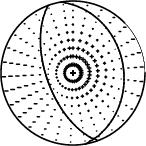
|
|
|
The best fit as a function of depth is given in the following figure:
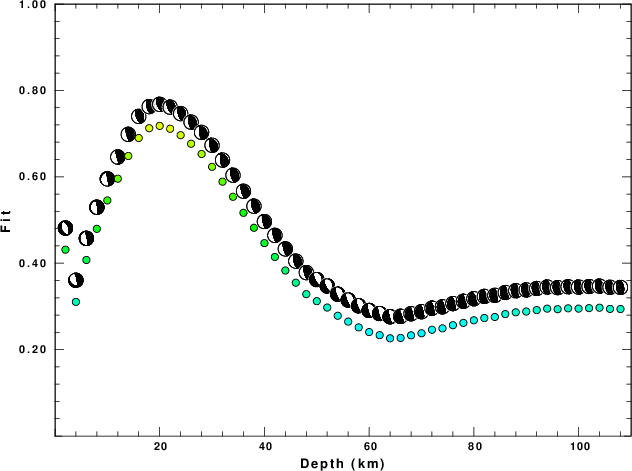
|
|
|
The comparison of the observed and predicted waveforms is given in the next figure. The red traces are the observed and the blue are the predicted. Each observed-predicted component is plotted to the same scale and peak amplitudes are indicated by the numbers to the left of each trace. A pair of numbers is given in black at the right of each predicted traces. The upper number it the time shift required for maximum correlation between the observed and predicted traces. This time shift is required because the synthetics are not computed at exactly the same distance as the observed and because the velocity model used in the predictions may not be perfect. A positive time shift indicates that the prediction is too fast and should be delayed to match the observed trace (shift to the right in this figure). A negative value indicates that the prediction is too slow. The lower number gives the percentage of variance reduction to characterize the individual goodness of fit (100% indicates a perfect fit).
The bandpass filter used in the processing and for the display was
cut a -30 a 180 rtr taper w 0.1 hp c 0.02 n 3 lp c 0.06 n 3
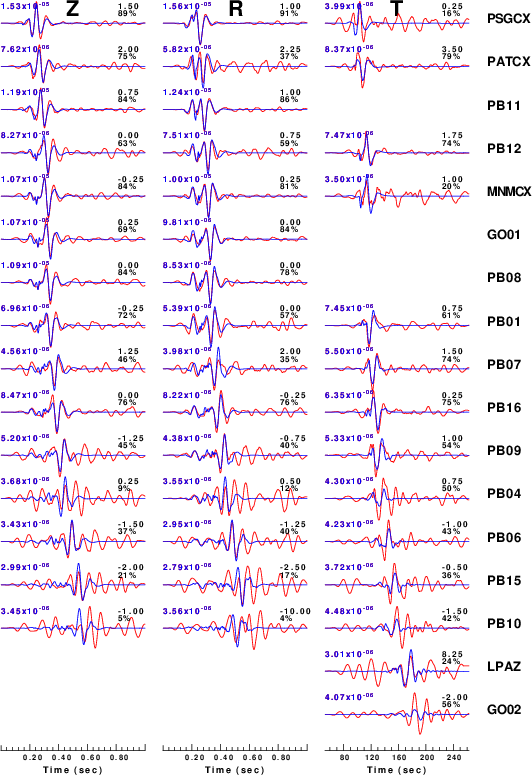
|
|
|
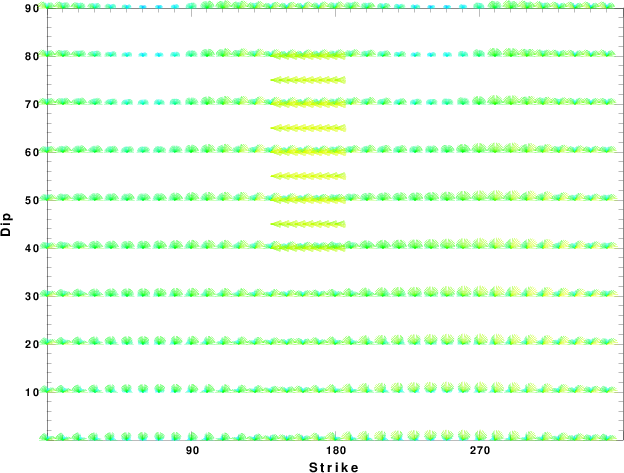
|
| Focal mechanism sensitivity at the preferred depth. The red color indicates a very good fit to thewavefroms. Each solution is plotted as a vector at a given value of strike and dip with the angle of the vector representing the rake angle, measured, with respect to the upward vertical (N) in the figure. |
A check on the assumed source location is possible by looking at the time shifts between the observed and predicted traces. The time shifts for waveform matching arise for several reasons:
Time_shift = A + B cos Azimuth + C Sin Azimuth
The time shifts for this inversion lead to the next figure:
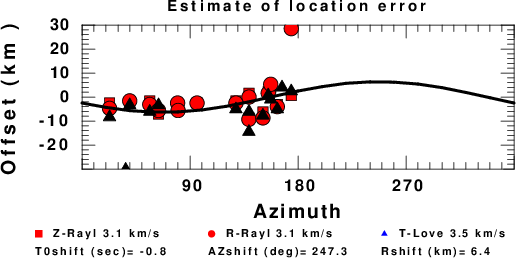
The derived shift in origin time and epicentral coordinates are given at the bottom of the figure.
Thanks also to the many seismic network operators whose dedication make this effort possible: University of Nevada Reno, University of Alaska, University of Washington, Oregon State University, University of Utah, Montana Bureas of Mines, UC Berkely, Caltech, UC San Diego, Saint Louis University, University of Memphis, Lamont Doherty Earth Observatory, the Iris stations and the Transportable Array of EarthScope.
The WUS used for the waveform synthetic seismograms and for the surface wave eigenfunctions and dispersion is as follows:
MODEL.01
Model after 8 iterations
ISOTROPIC
KGS
FLAT EARTH
1-D
CONSTANT VELOCITY
LINE08
LINE09
LINE10
LINE11
H(KM) VP(KM/S) VS(KM/S) RHO(GM/CC) QP QS ETAP ETAS FREFP FREFS
1.9000 3.4065 2.0089 2.2150 0.302E-02 0.679E-02 0.00 0.00 1.00 1.00
6.1000 5.5445 3.2953 2.6089 0.349E-02 0.784E-02 0.00 0.00 1.00 1.00
13.0000 6.2708 3.7396 2.7812 0.212E-02 0.476E-02 0.00 0.00 1.00 1.00
19.0000 6.4075 3.7680 2.8223 0.111E-02 0.249E-02 0.00 0.00 1.00 1.00
0.0000 7.9000 4.6200 3.2760 0.164E-10 0.370E-10 0.00 0.00 1.00 1.00
Here we tabulate the reasons for not using certain digital data sets
The following stations did not have a valid response files: